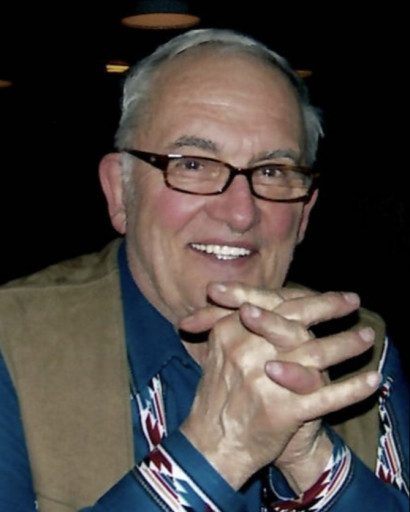

H. C. "Doc" Gurney, Jr.
October 20, 1930 — April 22, 2023
Evergreen, Colorado
H. C. "Doc" Gurney, Jr.
A BELOVED VETERINARIAN
H. C. “DOC” GURNEY, JR.
1930-2023
From an early age Doc loved challenges and adventure. He was drawn to the allure of the mountains, stories from Zane Grey, and thrilling tales over the radio. Smitten by the cowboy way of life, it was no surprise when on a family vacation to Yellowstone, he convinced his parents to stop at a working ranch. Although still in high school, he was hired on the spot and stayed to work while his parents returned to Chicago. After working the summer as a ranch hand, he went back to Chicago in the fall to continue his high school classes.
The cowboy life was everything he’d dreamed it would be. Each summer he returned to Wyoming immersing himself in the wild west: majestic mountains, bucking broncos, herds of cattle, rustic bunkhouses, tales around campfires---and just plain toughin’ and roughin’ it.
After high school, he attended Grinnell College for two years, and then enrolled at the University of Wyoming in Laramie. To pay for his tuition, board, books and supplies, he worked summers as a ranch hand at Snake River and Spur Ranch.
With the US embroiled in the Korean War, he volunteered for active duty and was trained as a sniper. However, his future took a life-changing path when he was assigned to the Medical Corps where he discovered his passion for science, medicine and research.
After active duty, he became a research assistant at Georgetown University School of Medicine, where he worked on a space project partially funded by the U.S. Atomic Energy Commission. During this time, he co-invented a biological life detection system that would later be utilized on the Mars Lander Viking Mission. Following this venture, he worked at Battelle Memorial Institute in Columbus, Ohio where he was involved with neonatal and adult stress responses, cancer, chemotherapy screening, and transplantation immunity.
With medicine and science as his chosen path, he attended Colorado State University Veterinary School of Medicine in Fort Collins, Colorado where he earned his doctorate. After graduation from CSU, he opened the Tri-State Veterinary Clinic in Cheyenne, Wyoming which served southeast Wyoming, western Nebraska, and northern Colorado.
During his years in Wyoming, he was elected and served in the House of Representatives for the Wyoming Legislature. He was known for his honesty and common sense with a desire to preserve freedom and liberty. But after one term, he did not run again, in order to practice veterinary medicine full-time. In addition to a full hospital schedule, he was also actively involved with Cheyenne Frontier Days as an on-site veterinarian. Always a strong supporter of law enforcement, he treated many mounted patrol horses and law enforcement canines, lauding their heroic feats.
He stated that he enjoyed veterinary medicine because animals are great teachers. They never lie, they validate. They do not let their emotion override a treatment. Either the therapy works, or it doesn’t.
Approximately ten years later, he moved to Colorado and opened Green Valley Ranch Veterinary Hospital in Conifer, and later established Aspen Park Veterinary Hospital. During his time in Colorado, he earned a reputation over a wide area with patients coming to him from all over the U.S.
His thirst for discovering treatments to help his patients was never-ending. He was a most unusual veterinarian who believed all systems are interrelated, including the effect of synergy and the importance of communication. He strongly felt that too much was overlooked or disregarded, and that a diagnosis was often formed too quickly based on early assumptions. His exceptionally brilliant mind kept him in a constant quest to help his patients. Doc was a giving man, always ready to go beyond. He gave most generously to the community—always concerned for animal welfare.
His interest in acupuncture was initiated after reading a book by Felix Mann describing the effectiveness of acupuncture in treating various conditions. When communication channels opened with China in the 1970’s, knowledge of other eastern treatments became more available. Dr. Gurney adapted them to his practice and became one of the pioneers in the U.S. for practicing acupuncture on animals. He dove into the study of various forms of healing techniques. Not always satisfied with the results after performing spinal surgery, he began utilizing acupuncture and noticed marked improvement in the restoration of function. He expanded his knowledge of alternative therapies, blending them with western medicine to treat a variety of conditions in animals.
For Doc, there was no such thing as leisure, all hours were dedicated to helping his patients. When not treating patients, he was always with a book, researching on a computer, or reading medical/scientific journals, on the cutting edge, far advanced from traditional methods.
His research included investigation of subtle energies of cell signaling, information communication, immune system behaviors, signal transduction, cellular responses, molecular components, mitochondria, and environmental interferences. With relentless determination he pursued unraveling the complexities of diseases including: auto-immune, metabolic, central nervous system, and cancer.
With a quick wit and dry sense of humor, he entertained clients and loved to educate pet owners. He firmly held that well-educated pet owners made better pet parents. His primary philosophy was pragmatism. He never gave up on a patient.
He traveled nationally and internationally. He has contributed to interdisciplinary groups (human and animal) and provided information through conferences, lectures, research, articles in newspapers, magazines and journals. He published articles, including: A Radioisotope Technique for the Rapid Detection of Coliform Organisms, (Levin, Harrison, Hess and Gurney- American Journal of Public Health, 1956), and A Simple, Effective Technique for Arresting Canine Epileptic Seizures (AHVMA Journal, 2004).
Toward the end of his career, he donated an eight-foot, wood-carved eagle to the grounds of the Cheyenne Veterans Affairs Hospital in Wyoming, honoring all who have served our country and those who support them.
At 90 years-of-age he published a book: The One-Eyed Buffalo and Other Adventurous Stories from the Life of Veterinarian, Doc Gurney.
Doc is preceded in death by his parents Elizabeth and Harry Sr., son Steven, and granddaughter Amber. Surviving members of the Gurney family include: wife Jan, sons Bruce and Jonathan, daughter Sarah, granddaughters Lauren and Morgan, grandsons Kellen and Cole, sister Janice Minton, and nieces Cathy Green, Elizabeth Myers, Cynthia Gwilliams, and Christie Hall.
A Celebration of Life TBD.
Doc Gurney: A Trailblazing Genius. One-of-a-Kind. We miss you!
Suggested Memorials:
Wild Animal Sanctuary - www.wildanimalsanctuary.org
ResQRanch – www.resqranch.org
Vested Interest in K9s - www.vik9s.org
An Animal Shelter or Rescue of Choice
Guestbook
Visits: 571
This site is protected by reCAPTCHA and the
Google Privacy Policy and Terms of Service apply.
Service map data © OpenStreetMap contributors





